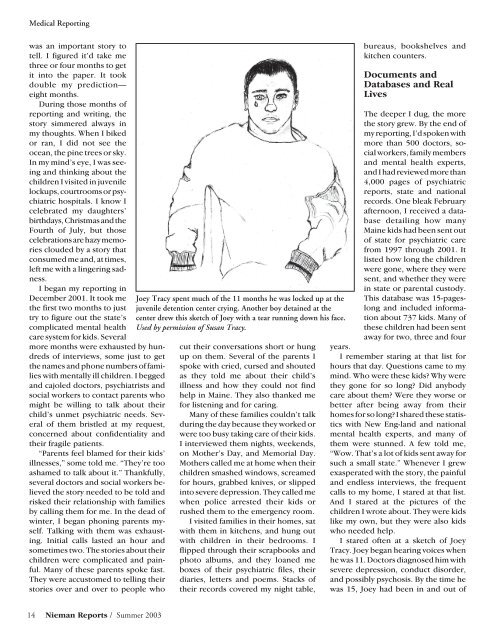summer-2003-Part 2-live - Nieman Foundation - Harvard University
summer-2003-Part 2-live - Nieman Foundation - Harvard University
summer-2003-Part 2-live - Nieman Foundation - Harvard University
- No tags were found...
You also want an ePaper? Increase the reach of your titles
YUMPU automatically turns print PDFs into web optimized ePapers that Google loves.
Medical Reportingwas an important story totell. I figured it’d take methree or four months to getit into the paper. It tookdouble my prediction—eight months.During those months ofreporting and writing, thestory simmered always inmy thoughts. When I bikedor ran, I did not see theocean, the pine trees or sky.In my mind’s eye, I was seeingand thinking about thechildren I visited in juvenilelockups, courtrooms or psychiatrichospitals. I know Icelebrated my daughters’birthdays, Christmas and theFourth of July, but thosecelebrations are hazy memoriesclouded by a story thatconsumed me and, at times,left me with a lingering sadness.I began my reporting inDecember 2001. It took methe first two months to justtry to figure out the state’scomplicated mental healthcare system for kids. Severalmore months were exhausted by hundredsof interviews, some just to getthe names and phone numbers of familieswith mentally ill children. I beggedand cajoled doctors, psychiatrists andsocial workers to contact parents whomight be willing to talk about theirchild’s unmet psychiatric needs. Severalof them bristled at my request,concerned about confidentiality andtheir fragile patients.“Parents feel blamed for their kids’illnesses,” some told me. “They’re tooashamed to talk about it.” Thankfully,several doctors and social workers believedthe story needed to be told andrisked their relationship with familiesby calling them for me. In the dead ofwinter, I began phoning parents myself.Talking with them was exhausting.Initial calls lasted an hour andsometimes two. The stories about theirchildren were complicated and painful.Many of these parents spoke fast.They were accustomed to telling theirstories over and over to people whoJoey Tracy spent much of the 11 months he was locked up at thejuvenile detention center crying. Another boy detained at thecenter drew this sketch of Joey with a tear running down his face.Used by permission of Susan Tracy.cut their conversations short or hungup on them. Several of the parents Ispoke with cried, cursed and shoutedas they told me about their child’sillness and how they could not findhelp in Maine. They also thanked mefor listening and for caring.Many of these families couldn’t talkduring the day because they worked orwere too busy taking care of their kids.I interviewed them nights, weekends,on Mother’s Day, and Memorial Day.Mothers called me at home when theirchildren smashed windows, screamedfor hours, grabbed knives, or slippedinto severe depression. They called mewhen police arrested their kids orrushed them to the emergency room.I visited families in their homes, satwith them in kitchens, and hung outwith children in their bedrooms. Iflipped through their scrapbooks andphoto albums, and they loaned meboxes of their psychiatric files, theirdiaries, letters and poems. Stacks oftheir records covered my night table,bureaus, bookshelves andkitchen counters.Documents andDatabases and RealLivesThe deeper I dug, the morethe story grew. By the end ofmy reporting, I’d spoken withmore than 500 doctors, socialworkers, family membersand mental health experts,and I had reviewed more than4,000 pages of psychiatricreports, state and nationalrecords. One bleak Februaryafternoon, I received a databasedetailing how manyMaine kids had been sent outof state for psychiatric carefrom 1997 through 2001. Itlisted how long the childrenwere gone, where they weresent, and whether they werein state or parental custody.This database was 15-pageslongand included informationabout 737 kids. Many ofthese children had been sentaway for two, three and fouryears.I remember staring at that list forhours that day. Questions came to mymind. Who were these kids? Why werethey gone for so long? Did anybodycare about them? Were they worse orbetter after being away from theirhomes for so long? I shared these statisticswith New Eng-land and nationalmental health experts, and many ofthem were stunned. A few told me,“Wow. That’s a lot of kids sent away forsuch a small state.” Whenever I grewexasperated with the story, the painfuland endless interviews, the frequentcalls to my home, I stared at that list.And I stared at the pictures of thechildren I wrote about. They were kidslike my own, but they were also kidswho needed help.I stared often at a sketch of JoeyTracy. Joey began hearing voices whenhe was 11. Doctors diagnosed him withsevere depression, conduct disorder,and possibly psychosis. By the time hewas 15, Joey had been in and out of14 <strong>Nieman</strong> Reports / Summer <strong>2003</strong>
















